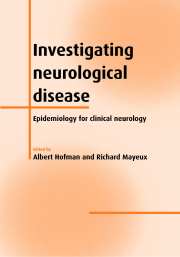Book contents
- Frontmatter
- Contents
- List of contributors
- Preface
- Part I Quantitative methods in clinical neurology
- Part II Neurological diseases
- 10 Cerebrovascular ischemic disease
- 11 Vascular dementia
- 12 Alzheimer's disease
- 13 Parkinson's disease
- 14 Multiple sclerosis
- 15 Myasthenia gravis
- 16 Guillain–Barré syndrome
- 17 Encephalitis and meningitis
- 18 HIV infection
- 19 Prion diseases
- 20 Neoplastic disease
- 21 Cerebral palsy
- 22 Migraine
- Index
17 - Encephalitis and meningitis
from Part II - Neurological diseases
Published online by Cambridge University Press: 29 September 2009
- Frontmatter
- Contents
- List of contributors
- Preface
- Part I Quantitative methods in clinical neurology
- Part II Neurological diseases
- 10 Cerebrovascular ischemic disease
- 11 Vascular dementia
- 12 Alzheimer's disease
- 13 Parkinson's disease
- 14 Multiple sclerosis
- 15 Myasthenia gravis
- 16 Guillain–Barré syndrome
- 17 Encephalitis and meningitis
- 18 HIV infection
- 19 Prion diseases
- 20 Neoplastic disease
- 21 Cerebral palsy
- 22 Migraine
- Index
Summary
The occurrence and clinical spectrum of infectious disorders of the central nervous system (CNS) in developed and developing countries present a temporal and geographic variability, depending on the variable distribution of the etiological agents and their vectors, different cultural attitudes towards disease control and prevention, and methodological inconsistencies of the available epidemiological studies. The latter include the use of different definitions of CNS infections, poor definition of the populations at risk, and incompleteness of diagnostic assessment. The majority of the studies are case reports, hospital series, and reports of presumed outbreaks of an infectious disease. These peculiarities and limitations must be considered when an assessment is made of the patterns of distribution and the comparability of the commonest rubrics of the CNS infections, i.e., encephalitis and meningitis.
Diagnosis
The infectious agents may provoke CNS impairment ranging from mild meningeal reactions to severe meningeal and/or parenchymal damage, which prevents clear separation between encephalitis and meningitis. With reference to standard criteria (1,2), encephalitis can be diagnosed in the presence of an acute or subacute onset of symptoms with neurological signs (clinical or laboratory) suggesting brain parenchyma involvement, in the absence of other diagnoses, including noninflammatory CNS infections. Meningitis can be defined by the presence of acute or subacute symptoms with signs of meningeal irritation and cerebrospinal fluid (CSF) pleocytosis (i.e., more than five leucocytes per mm3), with no signs of cerebral parenchyma involvement and no evidence of other diagnoses. Bacterial meningitis can be separated from viral (or aseptic) meningitis by the presence of at least 1000 white blood cells (WBC) with > 50% polymorphonucleocytes (PMNL) and/or glucose level <40 mg/dl, or less than 1000 WBC with > 50% PMNL and glucose level <40 mg/dl.
Keywords
- Type
- Chapter
- Information
- Investigating Neurological DiseaseEpidemiology for Clinical Neurology, pp. 230 - 245Publisher: Cambridge University PressPrint publication year: 2001

